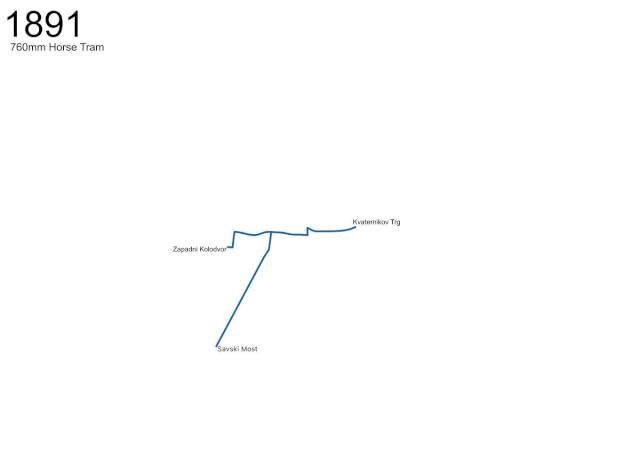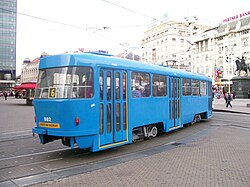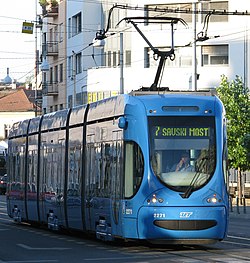Top Qs
Timeline
Chat
Perspective
Trams in Zagreb
Public transport system in Zagreb, Croatia From Wikipedia, the free encyclopedia
Remove ads
The Zagreb tram network, run by the Zagreb Electric Tram (ZET), consists of 15 day and 4 night lines in Zagreb, Croatia.[1] Trams operate on 116.3 kilometres (72.3 mi)[1] of metre gauge route. During the day, every line runs on average every 5–10 minutes, and almost every station serves at least two routes. Nighttime lines have exact timetables averaging at about every 40 minutes. The first horsecar tram line was opened in 1891,[2] and the first electric one in 1910.[2]
Remove ads
History
Summarize
Perspective

At the end of the 19th century, rapid urbanisation took place in Zagreb. As many European cities already had a tram network, Zagreb city officials started discussing the idea of installing a horsecar system as well. Zagreb newspaper Bič satirically wrote in 1885 “Trams have been introduced, but, of course, in Vienna, Graz and Budapest.”[4] The construction of the tracks began in 1889.[5] Trams should have been put in service on 15 August 1891, on the opening day of the Jubilee Economic-Forestry Exhibition.[6] Due to vehicle delivery delay, however, the tram was instead put in service on 5 September 1891, with a ticket costing 6 Hellers.[4][7] That day was officially taken as the beginning of an organised public transit system in Zagreb. The system was built on a 760 mm gauge (narrow gauge), and the track length was approximately 8 kilometres (5.0 mi).[8] What is now the Nikola Tesla Technical Museum was previously the location of the first tram depot in Zagreb, opened in 1891 on Savska street.[9] The first tram tracks spanned from Eugen Kvaternik Square to Mandaličina Street, branching off to West Railway Station and Sava Bridge. In the first year of operation, the network transported more than a million people, despite Zagreb having a population of only around 40,000.[7]

The first electric tram track was opened on 18 August 1910. The horse-drawn trams were kept for another year until a tram electric network was finished, after which they were moved to Velika Gorica where they remained in use until 1937.[4][10] The gauge was 1000 mm, and the network voltage was at first 550 V, but was later changed to 600 V.[8] The belgian company Compagnie Mutuelle de Tramways was commissioned to maintain and invest in the tram infrastructure.[11] In 1916, because of a lack of investment caused by the World War I, the service worsened, prompting the City Savings Bank to buy the majority of the shares of Zagreb Electric Tram, the transit authority in Zagreb, placing it in the hands of the city.[4] In 1923, the first tram changed its colour from yellow, orange and red to the signature blue, which would later become the default colour for public transport in the city.[5][12][13] Trams used to drive on the left side of the road until 1926, when traffic was reorganised and driving switched to the right side.[12] The tram depot on Savska Street was in use until 1936, when a new and bigger tram depot was built more westward in Ljubljanica.[14]
In the following years, the tram network expanded, even during World War II, under the leadership of Dragutin Mandl.[15] Tram service did get suspended and later removed from a street near Mirogoj in the aftermath of the 1954 accident, where 19 people were killed at a dangerously steep section.[16] The first trams crossed the Sava river in 1979, when Sopot, in the Novi Zagreb district, was connected with Držićeva street by the Youth Bridge (Most Mladosti).[17] In 1980, a new tram depot was built in Dubrava, in the east part of the city, as the population grew and the number of vehicles increased. Both depots are still in use.[18] The last tracks were opened in 2000, to Dubec and Prečko districts.[17]
Construction of tram tracks
Remove ads
Network
Summarize
Perspective

In 2024, ZET trams transported 121,83 million people, almost 333,773 every day.[32] The majority of stations serve multiple tram lines. Trams are more frequent on work days, especially during rush hour, and the least frequent on Sunday. Daytime lines come every 5–15 minutes on average.[33]
Daytime lines
Line 15 is a specific exception: the line is closer to a light rail line than an actual tram line. It runs for approximately 3 km from Mihaljevac to Dolje. The line runs on a completely segregated right of way. A special type of catenary was developed for the line, which allows trams to reach speeds of 60 km/h. Thus, the line from Mihaljevac to Dolje is the fastest and the shortest line in the entire tram network. It was opened in the 1950.[25]
Nighttime lines
Discontinued lines
Stops
Remove ads
Rolling stock
Summarize
Perspective
Past rolling stock
Zagreb got its first horse-drawn trams in 1891 - 10 closed and 6 open-air units.[4] These were made by the Graz factory, owned by the austrian businessman Johann Weitzer.[7][38] In 1910, by the time the horse-drawn trams started being phased out because of electrification of the network, the rolling stock had risen up to 17 closed and 15 open-air units.[7][4] The trams were transported to Velika Gorica, where they remained in use until 1937.[10] After the network was electrified, the first 28 electric T-50 trams started driving on the streets, produced by Ganz in Hungary. In 1911, an additional 7 T-70 trams were delivered, featuring a stronger engine and better brakes.[17] The first trams built in Zagreb by ZET were the M-22 trams, designed by Dragutin Mandl.[17] These trams entered production in 1922 and featured a wooden frame, characterized by a strong construction and a powerful engine.[4] Soon in 1924, the M-24, an upgraded version with a steel frame, started production. In the 40s and 50s, they were converted from double-end to single-end, and were put out of service in 1977, replaced by the Tatra T4YU trams.[39]
The first units built after World War II were the two-axle TMK 101 trams, a big upgrade from the M-24 trams. Also designed by Mandl, the first three prototype units (TMK 100) were built by ZET workshops in 1951, but after it was concluded that ZET did not have the capacity to build that many trams, the work was given to the Đuro Đaković factory.[40] Another 68 units with 110 matching trailers were built by 1965.[41] A few of them were replaced by the GT6 series, but they were in regular use until the TMK 2200 series came.[40] By mid-2007, only about 15 units of type 101 were still operational, serving only as a substitute for other vehicles.[42] They were eventually pulled out of service in late 2008.[40] TMK 201 trams, built from 1973 to 1975 by Đuro Đaković, were in operation until 2025.[43][44] ZET used to have a total of 30 units with 32 trailers, but half were scrapped and their bases were reused in the production of TMK 2100 trams in the 90s.[45][46] TMK 201 trams are similarly designed, but technically significantly different from the older TMK 101 trams, retired in 2008.[40][44]
From 1994 to 1998, ZET bought and received 35 used Duewag GT6 trams (5 of them are GT6 "type Mannheim") from Mannheim, Germany. They were brought as a temporary solution, as the lack of funds prevented the buying of new vehicles. All of the GT6 trams have since been replaced by the new TMK 2200 trams and scrapped.[47][48]
Current rolling stock
From 1976 to 1983, 95 Tatra T4YU units were manufactured for Zagreb by ČKD. The T4YU units are a type of the T4 series made for Yugoslavia, and have the same equipment as T4D units, which were used in Germany. They were nicknamed "Čeh" (meaning "a Czech"). The trams came with corresponding B4YU trailers.[49][50] From 1985 to 1986, Zagreb received 51 new articulated Tatra KT4YU trams, a type of the KT4 series, which were nicknamed "Katica".[51][52]
In 1994, Končar built the TMK 2101 tram, a prototype of the TMK 2100, which was later produced from 1997 to 2003.[47] A total of 16 units were built, including the prototype.[53] In 2003, ZET ordered 70 new low-floor TMK 2200 trams from Crotram, a consortium led by Končar.[54] In May 2005, the first prototype was delivered.[55] It features air-conditioning, cameras outside (instead of rear view mirrors) and inside, and a maximum speed of 70 km/h.[56][57] Although Crotram designates these trams as TMK 2200, ZET designates them as NT 2200.[58] The last tram of the original order was delivered on 28 May 2007, and on 7 June, Zagreb organised a tram parade where all 70 TMK 2200 trams drove through the streets of Zagreb, to celebrate a new generation of low-floor trams.[59][60] In July 2007, a contract for an additional 70 TMK 2200 vehicles was signed, which would have a redesigned seat layout allowing wider passages and additional handrails on the ceiling.[54][61][62] The 140th unit entered service on 30 June 2010, featuring a redesigned seat layout allowing wider passages, and additional handrails on the ceiling.[63] In 2009 and 2010, ZET received 2 TMK 2300 (TMK 2200K) trams, shorter versions of TMK 2200s. They operate on less busy and nighttime lines.[64]
In spring of 2023, the city initiated an international public tender for the purchase of 11 second-hand trams worth €2.7 million, to which Stadtwerke Augsburg responded by offering 11 Adtranz GT6M trams.[65] ZET received the first unit on 1 December, and after testing, the tram went into service on 27 December.[66][67] In September 2024, ZET signed a contract with Končar to buy a total of 40 new TMK 2400 trams, an upgraded version of the TMK 2200 model, worth around €80 million.[68] The first unit entered service on 10 March 2025.[69]
Today, the rolling stock includes 259 motor units of 8 different tram types, of which 154 are low-floor trams.[70] Most of the stock today consists of TMK 2200 trams, a total of 140 units acquired from 2005 to 2010. The next most common tram type is made by ČKD, comprising a total of 95 T4YU units with 85 matching B4YU trailers, and 51 articulated KT4YU units.[50][53] T4YU vehicles entered service between 1976 and 1983, and KT4YU followed in 1985.[53]
Museum units
ZET preserves old trams for showcases on ZET anniversaries, and for occasional rides on the museum line 21.[71] This includes two museum units of M-24 trams, one with a "Košak" trailer built by ZET, and the other with "Pagoda" trailer, which was formerly a motor car made by Ganz. These trams are used for kids rides during the Zagreb Christmas Market.[39] ZET also has TMK 101 and 201 museum units.[43][41]
Tram types
Trailer types
Remove ads
Gallery
- ĐĐ TMK 201, 30 units built 1973-1974. by Đuro Đaković
- ČKD Tatra T4YU, Type 401, 95 units built 1976-1982.
- ČKD Tatra KT4YU, Type 301, 51 units built 1985-1986.
- Adtranz GT6M, 6 units bought from Augsburg 2023. - 2025., further 5 on order
- TMK 2400, 14 units delivered in 2025., with further 26 on order.
Remove ads
See also
References
External links
Wikiwand - on
Seamless Wikipedia browsing. On steroids.
Remove ads



























